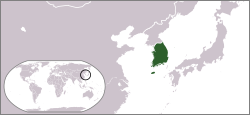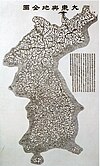This article needs additional citations for verification. (June 2023) |
Republic of Korea 대한민국 大韓民國 | |||||||||
|---|---|---|---|---|---|---|---|---|---|
| 1981–1988 | |||||||||
Motto:
| |||||||||
| Anthem: 애국가 "Aegukga" | |||||||||
| National seal "국새" | |||||||||
 | |||||||||
| Capital | Seoul | ||||||||
| Common languages | Korean | ||||||||
| Demonym(s) | South Korean Korean | ||||||||
| Government | Unitary semi-presidential republic under an authoritarian military dictatorship | ||||||||
| President | |||||||||
• 1981–1988 | Chun Doo-hwan | ||||||||
| Prime Minister | |||||||||
• 1981–1982 | Nam Duck-woo | ||||||||
• 1982 | Yoo Chang-soon | ||||||||
• 1982–1983 | Kim Sang-hyup | ||||||||
• 1983–1984 | Chin Iee-chong | ||||||||
• 1985–1987 | Lho Shin-yong | ||||||||
• 1987 | Lee Han-key (acting) | ||||||||
• 1987–1988 | Kim Chung-yul | ||||||||
| Legislature | National Assembly | ||||||||
| Historical era | Cold War | ||||||||
• Established | 25 February 1981 | ||||||||
| 16 December 1987 | |||||||||
| 25 February 1988 | |||||||||
| Currency | South Korean won | ||||||||
| |||||||||
| History of South Korea |
|---|
 |
|
|
The Fifth Republic of Korea (Korean: 제5공화국; RR: Je 5 Gonghwaguk; lit. "Fifth Republic") was the government of South Korea from February 1981 to February 1988.[1]
The Fifth Republic was established in February 1981 by Chun Doo-hwan, a military colleague of long-time president and dictator Park Chung Hee, after the political instability and military rule in the fourth republic since the assassination of Park in October 1979. The Fifth Republic was ruled by Chun and the Democratic Justice Party as a de facto dictatorship and one-party state. The Fifth Republic faced growing opposition from the democratization movement of the Gwangju Uprising, and the June Democracy Movement of 1987 resulted in the election of Roh Tae-woo in the December 1987 presidential election. The Fifth Republic was dissolved three days after the election upon the adoption of a new constitution that laid the foundations for the relatively stable democratic system of the current sixth Republic of Korea.
- ^ Hinton, Harold C. (1983). Korea under new leadership : the Fifth Republic. New York, NY: Praeger. ISBN 0-03-063284-6. OCLC 9219028.


